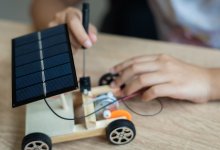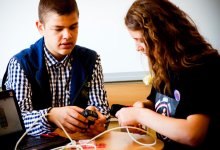Collaborative Learning
Working together to solve problems and complete projects deepens students’ learning and builds collaborative skills. Learn how to design activities to help develop these skills.
How STEM Projects Support Belonging in Middle School
When students engage in hands-on, collaborative problem-solving, they see themselves as essential to their classroom community.1kYour content has been saved!
Go to My Saved Content.Exploring Narrative Elements Through a Drama Game
Using an improv exercise to practice the parts of a story gets ideas flowing for students—and helps them add structure to their writing.Activating Learning by Milling to Music
When students pretend they’re at a fancy party making small talk, a simple brainstorm for writing ideas becomes more lively, more cooperative—and more effective.464.8kYour content has been saved!
Go to My Saved Content.Improv in the Classroom
A collection of our popular articles and videos about how theater games and improvisation can spark creativity, build relationships, and boost academics and executive function skills alike.115.7kYour content has been saved!
Go to My Saved Content.16 Variations on Think-Pair-Share to Keep Students Engaged
Teachers and students use this classic learning strategy often. To keep it from getting stale, try these tweaks.22 Powerful Closure Activities
Quick activities that can be used to check for understanding or emphasize key information at the end of a lesson.1.1MYour content has been saved!
Go to My Saved Content.How Classroom Jobs for Teens Instill Responsibility
When middle and high school students take ownership of tasks in their classroom regularly, they build a culture of teamwork and support.60-Second Strategy: Whiteboard Relay
The team competition is fierce in this informal assessment activity, in which students have to work together to win.159.1kYour content has been saved!
Go to My Saved Content.60-Second Strategy: Respond, Reflect, and Review
This simple activity helps students practice giving and receiving peer feedback—and gets them out of their desks.314.7kYour content has been saved!
Go to My Saved Content.Student-Centered Learning: It Starts With the Teacher
Teachers encourage student-centered learning by allowing students to share in decisions, believing in their capacity to lead, and remembering how it feels to learn.480.3kYour content has been saved!
Go to My Saved Content.Golden Rules for Engaging Students in Learning Activities
Six factors to consider in designing lessons to help increase student engagement behaviorally, emotionally, and cognitively.442.8kYour content has been saved!
Go to My Saved Content.60-Second Strategy: Cooperative Learning Roles
Giving students randomly assigned roles in their group work helps ensure that they all participate.270.3kYour content has been saved!
Go to My Saved Content.Strategies for Maximizing Google Docs in Middle and High School
This common tool that you use every day can facilitate student collaboration and engagement in learning.5.4kYour content has been saved!
Go to My Saved Content.Taking a Playful Approach to Assessment
When teachers bring collaboration, creativity, and choice into assessment, anxiety and dread give way to confidence and joy as students show off what they have learned.85.4kYour content has been saved!
Go to My Saved Content.Overcoming Student Fears Surrounding Class Discussions
Teachers can increase participation in student-led dialogues such as Socratic seminars by addressing common sources of anxiety.8.8kYour content has been saved!
Go to My Saved Content.












